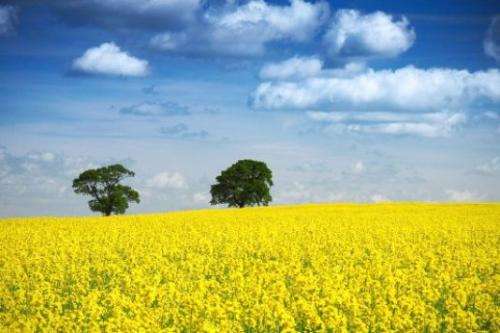Developing new methods to assess resistance to disease in young oilseed rape plants

Being able to measure resistance to disease in young oilseed rape plants is vital in the battle to breed new disease resistant varieties of the crop, and is the focus of a study by a team of researchers led by the University of Hertfordshire.
The battle against phoma stem canker
Oilseed rape is prone to phoma stem canker, also known as blackleg disease, which is responsible for losses worth more than £1,200 million in oilseed rape crops across the world. With the fragile state of the world's economy and concern over food shortages, there is a need to protect arable crops from disease. However, assessing disease resistance in young oilseed rape plants is difficult as there is a long period where the pathogen is not visible – it can infect plants and continue to grow without showing symptoms.
Greater inbuilt resistance needed
Bruce Fitt, professor of plant pathology at the University of Hertfordshire, said: "Plant disease epidemics are bad news for farmers. There has been a heavy reliance on fungicides to control disease but some of the most effective fungicides are now being withdrawn through EU regulations. So there is a need to develop oilseed crop varieties with greater inbuilt resistance to the disease.
"Although oilseed rape crops in the UK are bred for disease resistance, it is a difficult and expensive process – both in time and money – to develop new disease resistant varieties."
Traditionally, selection of disease resistant oilseed crops has relied on field assessments of disease severity on stems, which are made towards the end of the cropping season when the symptoms have become visible on the adult plants – typically about eleven months after sowing. Crops also need to be grown at various sites to assess the impact of location on disease resistance – adding yet more cost and time to the assessment.
Assessing disease resistance in young oilseed rape plants
Professor Fitt continued: "If resistance can be assessed in young oilseed rape plants, it will not only accelerate the process of breeding oilseed rape crops for resistance but will also save money for the industry. Our study investigates new methods for assessing disease resistance in young plants."
The paper, based on experiments done by Dr Yong-Ju Huang at Rothamsted Research, shows that resistance in young oilseed rape plants can be detected in controlled conditions - and suggests that the methods should be further evaluated to develop techniques which can be reliably used by breeders to select for quantitative resistance in young plants. This will not only save money but also accelerate the process of breeding for resistance.
More information: Huang Y-J, Qi A, King GJ, Fitt BDL (2014) Assessing Quantitative Resistance against Leptosphaeria maculans (Phoma Stem Canker) in Brassica napus (Oilseed Rape) in Young Plants. PLoS ONE 9(1): e84924. DOI: 10.1371/journal.pone.0084924
Provided by University of Hertfordshire
















